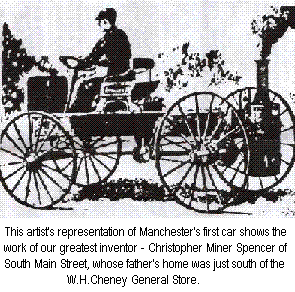
REPRINTS

In Manchester, during the Civil War, Christopher Spencer built and operated what seems to have been the first successful
automobile in Connecticut.

That steam auto of 1862 was an ordinary four-wheeled buggy to which Spencer added a steam boiler and a two-cylinder
engine. The boiler burned coal and the boiler tubes were made out of rejected Spencer rifle barrels.
It was built to carry the inventor to and from his job, but he tested its speed and reported that on a race track, it
could keep up with trotting horses. Its speed was limited, though, by the poor roads of the time and its use was limited
by a poor attitude toward progress.
Manchester officials ordered Spencer to keep the vehicle off the roads because it made too much noise and frightened
horses, who would go nowhere near it.
Spencer built several of the vehicles in the 1860s. One source gave him credit for having the first automobile
accident -- when he sheared the wheel off a milk wagon in Boston.
From the 1880s into the 20th century, Spencer continued to work with steam autos, which attracted spectators when he
took them on the streets. He made several in Windsor and when his son, Roger, drove one to New York in 1901, the Hartford
Times reported that he averaged 13 mph despite roads that weren't in the best of shape.
In 1989, Spencer's last surviving child, Percival, then 92, recalled that about 1904, his father made about 10 steam
cars that burned kerosene to be used for deliveries by a New York City dairy. The inventor gave Percival a castoff steam
engine and a boiler from a prototype of the cars and the boy put together a vehicle of his own.
"By God, I got it running," Percival recalled. He attended Windsor school and, with schoolmates helping, he kept the
auto powered by burning shingles in it. He couldn't afford kerosene.
"You had to stoke pretty fast," he said.
Ed. Note: To view a biography of Christopher Spencer, from the 1886 "Hollister Family of America" geneaology compiled by Layafette Wallace Case MD, which is also accessible in this web site's "Vintage Reprints" section, please click: here.